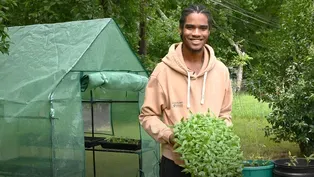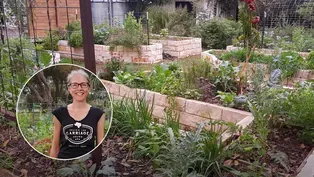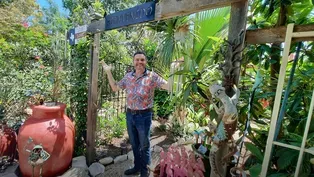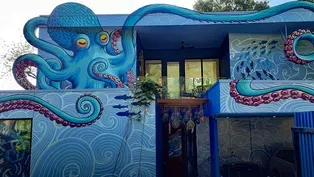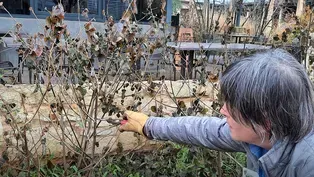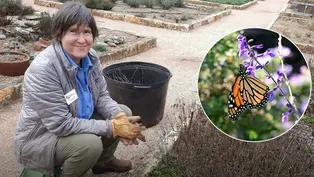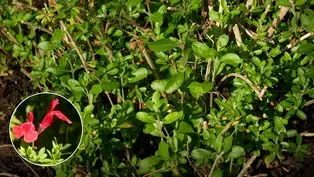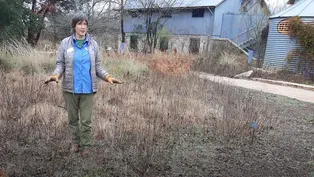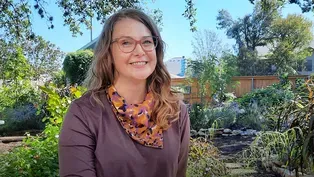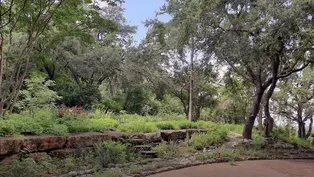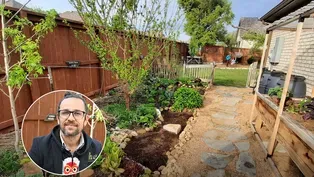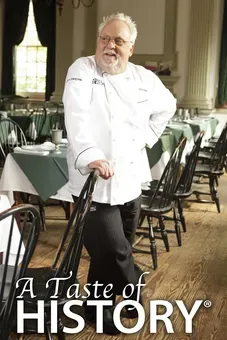
Native Plant Garden in HOA: Martin Byhower
Clip: Season 28 | 8m 42sVideo has Closed Captions
A California-to-Texas environmentalist helps neighbors garden for wildlife in extreme weather.
Helping neighbors garden for wildlife in extreme weather swings energizes Martin Byhower every day. A retired science teacher, when he and wife Eileen moved from California to in Georgetown, Texas, he studied up local native plants to carry on as an environmental activist, landscape designer, and birding guide.
Problems with Closed Captions? Closed Captioning Feedback
Problems with Closed Captions? Closed Captioning Feedback
Central Texas Gardener is a local public television program presented by Austin PBS
Support for CTG is provided by: Lisa & Desi Rhoden, and Diane Land & Steve Adler. Central Texas Gardener is produced by Austin PBS, KLRU-TV and distributed by NETA.

Native Plant Garden in HOA: Martin Byhower
Clip: Season 28 | 8m 42sVideo has Closed Captions
Helping neighbors garden for wildlife in extreme weather swings energizes Martin Byhower every day. A retired science teacher, when he and wife Eileen moved from California to in Georgetown, Texas, he studied up local native plants to carry on as an environmental activist, landscape designer, and birding guide.
Problems with Closed Captions? Closed Captioning Feedback
How to Watch Central Texas Gardener
Central Texas Gardener is available to stream on pbs.org and the free PBS App, available on iPhone, Apple TV, Android TV, Android smartphones, Amazon Fire TV, Amazon Fire Tablet, Roku, Samsung Smart TV, and Vizio.
Providing Support for PBS.org
Learn Moreabout PBS online sponsorship- There's a lot to learn.
There's 5000 species of native plants in Texas, and I wanted to find the equivalent ones that I knew about already that were valuable for wildlife from doing habitat restoration work in Southern California.
So, I moved here from Southern California, where I was a science teacher and birding guide for about 30 odd years.
And we moved to Sun City, Texas, here in Central Texas, so I could be a kid in a candy store and start all over again with a whole new set of nature.
Because I was a naturalist in California and I was doing habitat restoration, and I wanted to do similar things here.
I did a lot of courses with the Native Plant Society and with other groups, and I jumped right in and learned the nature and then started my own wildlife business here where I'm planting native plant gardens.
One of the things that brought us here was this yard full of heritage oaks.
I mean, it's got its challenges, because they create a lot of shade.
And the only part of our yard that was sunny is the front.
So I wanted to do sun, pollinators and birds in the front that's a little more acceptable to an HOA and then the backyard became sort of a laboratory for experimenting with the kinds of plants that would be both aesthetically pleasing but also support wildlife.
I wanted to create a lot of diversity.
There was very low diversity when we moved in and now I've got about 150 different species of plants in my yard, blooming at different times of the year.
- I look at things now and I think "This is nirvana.
"This is wonderful, yeah."
- Moving here was a challenge, especially in the front yard where people walk by and the community standards have rules that might affect what I can do.
So, the very first thing was I got a permit to get rid of all the turf.
I wanted to create levels, wildlife likes different levels and different variety, things blooming at different times of year, different colors of plants.
But I also wanted to create a lot of interest.
So, creating different elevations, having a walkway, having rocks, having all these different features, mulch beds as well as some rock beds, would make it interesting and appealing.
So my yard could be an example of what is possible working within the confines of an HOA.
The deer love to eat anything that is not deer resistant.
So, learning what's deer resistant has been really important.
Also, learning how to protect plants from the deer is really important too.
One of the things is dealing with deer.
We have been up until now restricted to four-foot fences, and the deer can easily go over that.
But one of the things you can do to keep deer out of your yard is to put yard art or plants up against the fence to kind of circle the perimeter, because deer don't have depth perception.
Their eyes are on each side, and so they need to see a landing place or they won't jump over the fence.
Most of my yard is shade.
I have these huge heritage oaks, and with turf requirements, it's very difficult to keep turf alive in shade, especially where I live.
I'm in the drainage path, and my yard sometimes becomes a river.
All the soil had even washed away.
And I was able to find a way to restore that into a little beautiful community with inland sea oats and frostweed and Turk's cap and tropical salvia and various sedges.
So, just by planting in between the roots and giving things a start of the trees, I didn't have to bury the roots, which you don't want to do to an oak tree, so I didn't have to cut through a lot of the roots you just plant in between.
And what happened was that area now when soil and mulch and compost gets washed downstream, it hits that area that stops it, so it's built up its own community.
And now it's full of wildlife and flowers and plants, and it's become something of beauty.
There are plants that attract bugs.
Frostweed is probably my favorite.
One of my absolute favorite plants.
It grows in full shade.
Deer don't eat it and I use it as an insectary as well.
It may be the most important plant for southbound monarch butterflies in fall.
I've never use pesticides in my yard.
All I need are the plants that first attract the bugs and then attract the things that eat the bugs.
So, I've got lizards, I've got birds, I've got all kinds of things preying on insects in my yard.
It's all about balance.
When people start using pesticides, what they do is they kill off everything, all the food for the lizards and the birds and all the good insects like dragonflies and damselflies, eat more mosquitoes than any other critter.
To get wildlife into your yard and most people want birds and things like that, you have to plant the right kinds of plants in the right kinds of densities and in the right combinations.
You have in other words diversity is what brings in wildlife, and density does too.
So, it's really good to plant in clusters.
Birds need cover, they need nesting materials, they need shelter, they need places to hide and they need food.
I feed the birds with my flowers and Turk's cap, coral honeysuckle, flame acanthus, things like that, they're fantastic for hummingbirds, so I plant those a lot.
I've got a lot of these yaupons in my yard.
And they in spring, in early spring will be just swarming with bees.
And then along comes January, when the berries are full and they'll be swarming with cedar wax wings.
And I have a I've got videos of hundreds of cedar wax wings that I can see from looking out my window.
In my yard we've had 106 species of birds.
We have resident species, we have wintering species, we have migratory species and we have birds that are here breeding in the summer.
So, in the summer we have things like, summer tanager sticking around.
In the winter we have the beautiful singing, white throated sparrows.
I have camera that I can see, the birds that are at my bird feeders.
I can just watch it in real time, stream it to my television and I can see what's going on in my yard if I don't want to actually sit out in my yard, because it's too hot.
My yard becomes a river at times.
And what I've had to do is figure out ways besides planting things to catch sediment, other ways to to adapt and stabilize the yard.
In places where the water creates erosion and comes down really fast, I wanted to slow it down.
So, I've planted things like buttonbush, elbow bush, bushy bluestem as sort of like rain gardens to sort of divert the flow.
But I still have areas where water comes down or the dogs, because we have two very active young poodles.
And so I have to find areas that I have bare spots and you're not supposed to have bare spots.
So, what we're going to do is we're going to put in a paver pathway along there.
But also I have some sensitive areas where I have my bird feeders and I have some more sensitive plants, and I have to keep the dogs out.
So, I've put in caging metal, metal edging caging with with stakes.
I find a lot of people want a visual barrier, especially if their houses are close to other houses.
And there are shrubs that you can use if you have sun that are really good, some that are evergreen, like the Texas green sage, there's different varieties of that.
And that's beautiful purple flowers.
So if you want a gentle screen, that's also really pretty, there's a lot of understory trees that you can use, ornamental understory trees.
And I have a row, for example, in my backyard that has anacacho orchid, Texas persimmon.
And those persimmons are delicious if you get to them before the the critters do, anacua, possumhaw, possumhaw holly is great, because it's got the red berries in the in the winter.
So, I feel like if we want to keep the beauty and the diversity and the natural features that that draw many people here, that drew me to this community, we're all going to have to participate.
We need to help wildlife.
We need to create a national park with our houses, a place where where wildlife can persist and and live.
And the best way to do that is by planting natives or even non-natives that are adapted that also are beneficial for wildlife and that are noninvasive.
And we have to work and get people on to the community associations, on to the homeowner associations, into city councils, in city government.
People have to realize what's happening and change and adapt, because we're not going to get more water and we're not going to miraculously get better conditions of weather and climate and our yards are going to have to become the places where wildlife persist.
Growing Community: Body and Soul
Video has Closed Captions
Lenny West found his anchor and mission in providing fresh vegetables to food desert neighbors. (6m 18s)
Native Plant Garden in HOA: Martin Byhower
Video has Closed Captions
A California-to-Texas environmentalist helps neighbors garden for wildlife in extreme weather. (8m 42s)
Permaculture Design: Raised Beds and Food Forest
Video has Closed Captions
Limestone raised beds and a mandala-designed food forest honor resourceful permaculture tenets. (9m 15s)
Creating Moods in a Regular Backyard
Video has Closed Captions
Imagination, creative reuse, and spirited fun turned a backyard into a sensory voyage. (7m 41s)
Video has Closed Captions
New gardener Nancy Hall relied on plants–adapted and native–to teach her their ways. (7m 49s)
Artistic Collaboration Goes with the Flow
Video has Closed Captions
When rainwater runoff plagued a family’s home, they plunged into a whimsical makeover. (8m 25s)
Winter Pruning: Wax Mallow for Spring’s Spiderworts
Video has Closed Captions
See how to cut back wax mallow (turk’s cap) to show off spring-blooming spiderworts. (3m 25s)
Winter Pruning: Mealy Blue Sage
Video has Closed Captions
See where to cut back old stalks on perennial mealy blue sage. (3m 16s)
Video has Closed Captions
Learn how to prune this evergreen woody shrub/subshrub. (4m 47s)
Video has Closed Captions
See why to progressively prune grasses and herbaceous perennials. (1m 35s)
Garden Makeover Grows New Friends and Career
Video has Closed Captions
Jennie Ostertag broke a few shovels changing her yard and life’s path. (9m 18s)
Video has Closed Captions
James Truchard created diverse habitats to offset a future of climate changes. (8m 49s)
Drought Design: Change of Plans & Plants
Video has Closed Captions
Mistakes led new gardeners back to the drawing board with native plants. (8m 55s)
Side Yard Garden Permaculture Design
Video has Closed Captions
A narrow side yard supports food and flowers with permaculture techniques. (8m 1s)
Front Yard Native Plant Wildlife Habitat
Video has Closed Captions
Removing lawn for native plants brings pollinators to a young couple’s front yard. (9m 35s)
Providing Support for PBS.org
Learn Moreabout PBS online sponsorshipSupport for PBS provided by:
Central Texas Gardener is a local public television program presented by Austin PBS
Support for CTG is provided by: Lisa & Desi Rhoden, and Diane Land & Steve Adler. Central Texas Gardener is produced by Austin PBS, KLRU-TV and distributed by NETA.
